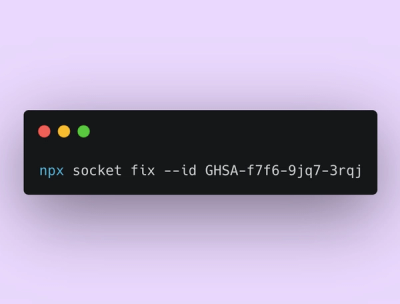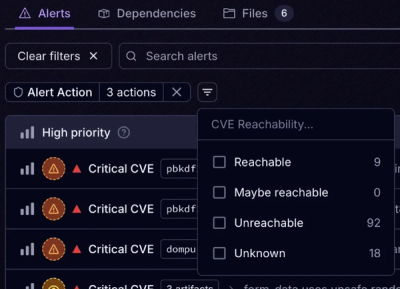
Product
Announcing Socket Fix 2.0
Socket Fix 2.0 brings targeted CVE remediation, smarter upgrade planning, and broader ecosystem support to help developers get to zero alerts.
Working on an experimental new design? Starting a closed beta? Rolling out a new feature over the next few weeks? Fa-fa-fa-flip it. fflip gives you complete control over releasing new functionality to your users based on their user id, join date, membership status, and whatever else you can think of. fflip's goal is to be the most powerful and extensible feature flipping/toggling module out there.
As mentioned, fflip's goal is to be flexible enough to integrate with any web framework, database, or ORM. The following integrations are known to exist:
If you're interested in creating an integration, don't hesitate to reach out or create an issue if some functionality is missing. And if you've created an integration, please add it to the list above!
Below is a simple example that uses fflip to deliver a closed beta to a fraction of users:
// Include fflip
let fflip = require('fflip');
fflip.config({
criteria: ExampleCriteria, // defined below
features: ExampleFeatures // defined below
});
// Get all of a user's enabled features...
someFreeUser.features = fflip.getFeaturesForUser(someFreeUser);
if(someFreeUser.features.closedBeta === true) {
console.log('Welcome to the Closed Beta!');
}
// ... or just check this single feature.
if (fflip.isFeatureEnabledForUser('closedBeta', someFreeUser) === true) {
console.log('Welcome to the Closed Beta!');
}
Criteria are the rules that define access to different features. Each criteria takes a user object and some data as arguments, and returns true/false if the user matches that criteria. You will use these criteria to restrict/allow features for different subsets of your userbase.
let ExampleCriteria = [
{
id: 'isPaidUser',
check: function(user, isPaid) {
return user.isPaid == isPaid;
}
},
{
id: 'percentageOfUsers',
check: function(user, percent) {
return (user.id % 100 < percent * 100);
}
},
{
id: 'allowUserIDs',
check: function(user, allowedIDs) {
return allowedIDs.indexOf(user.id) > -1;
}
}
];
Features represent some special behaviors in your application. They also define a set of criteria to test users against for each feature. When you ask fflip if a feature is enabled for some user, it will check that user against each rule/criteria, and return "true" if the user passes.
Features are described in the following way:
let ExampleFeatures = [
{
id: 'closedBeta', // required
// if `criteria` is in an object, ALL criteria in that set must evaluate to true to enable for user
criteria: {isPaidUser: true, percentageOfUsers: 0.50}
},
{
id: 'newFeatureRollout',
// if `criteria` is in an array, ANY ONE set of criteria must evaluate to true to enable for user
criteria: [{isPaidUser: true}, {percentageOfUsers: 0.50}]
},
{
id: 'experimentalFeature',
name: 'An Experimental Feature', // user-defined properties are optional but can be used to add important metadata on both criteria & features
description: 'Experimental feature still in development, useful for internal development', // user-defined
owner: 'Fred K. Schott <fkschott@gmail.com>', // user-defined
enabled: false, // sets the feature on or off for all users, required if `criteria` is not present
},
]
The value present for each rule is passed in as the data argument to it's criteria function. This allows you to write more general, flexible, reusable rules.
Rule sets & lists can be nested and combined. It can help to think of criteria sets as a group of AND operators, and lists as a set of OR operators.
If you'd like to allow wider access to your feature while still preventing a specific group of users, you can use the $veto property. If the $veto property is present on a member of a criteria list (array), and that member evaluates to false, the entire list will evaluate to false regardless of it's other members.
{
// Enabled if user is paid OR in the lucky 50% group of other users currently using a modern browser
criteria: [{isPaidUser: true}, {percentageOfUsers: 0.50, usingModernBrowser: true}]
// Enabled if user is paid OR in the lucky 50% group of other users, BUT ONLY if using a modern browser
criteria: [{isPaidUser: true}, {percentageOfUsers: 0.50}, {usingModernBrowser: true, $veto: true}]
}
.config(options) -> void: Configure fflip (see below).isFeatureEnabledForUser(featureName, user) -> boolean: Return true/false if featureName is enabled for user.getFeaturesForUser(user) -> Object: Return object of true/false for all features for user.reload() -> void: Force a reload (if loading features dynamically)Configure fflip using any of the following options:
fflip.config({
criteria: {}, // Criteria Array
features: {}, // Features Array | Function (see below)
reload: 30, // Interval for refreshing features, in seconds
});
fflip also accepts functions for loading features. If fflip is passed a function with no arguments it will call the function and accept the return value. To load asynchronously, pass a function that sends a features object to a callback. fflip will receive the callback and set the data accordingly. In both cases, fflip will save the function and call it again every X seconds, as set by the reload parameter.
// Load Criteria Synchronously
let getFeaturesSync = function() {
let collection = db.collection('features');
let featuresArr = collection.find().toArray();
/* Process/Format `featuresArr` if needed (format described above) */
return featuresArr;
}
// Load Features Asynchronously
let getFeaturesAsync = function(callback) {
let collection = db.collection('features');
collection.find().toArray(function(err, featuresArr) {
/* Handle err
* Process/Format `featuresArr` if needed (format described above) */
callback(featuresArr);
});
}
fflip.config({
criteria: ExampleCriteriaObject,
features: getFeaturesAsync, // or: getFeaturesSync
reload: 60 // update available features every 60 seconds
});
Original logo designed by Luboš Volkov
FAQs
Flexible Feature Flipping/Flagging for Node.js
We found that @esm/fflip demonstrated a not healthy version release cadence and project activity because the last version was released a year ago. It has 1 open source maintainer collaborating on the project.
Did you know?

Socket for GitHub automatically highlights issues in each pull request and monitors the health of all your open source dependencies. Discover the contents of your packages and block harmful activity before you install or update your dependencies.

Product
Socket Fix 2.0 brings targeted CVE remediation, smarter upgrade planning, and broader ecosystem support to help developers get to zero alerts.

Security News
Socket CEO Feross Aboukhadijeh joins Risky Business Weekly to unpack recent npm phishing attacks, their limited impact, and the risks if attackers get smarter.

Product
Socket’s new Tier 1 Reachability filters out up to 80% of irrelevant CVEs, so security teams can focus on the vulnerabilities that matter.